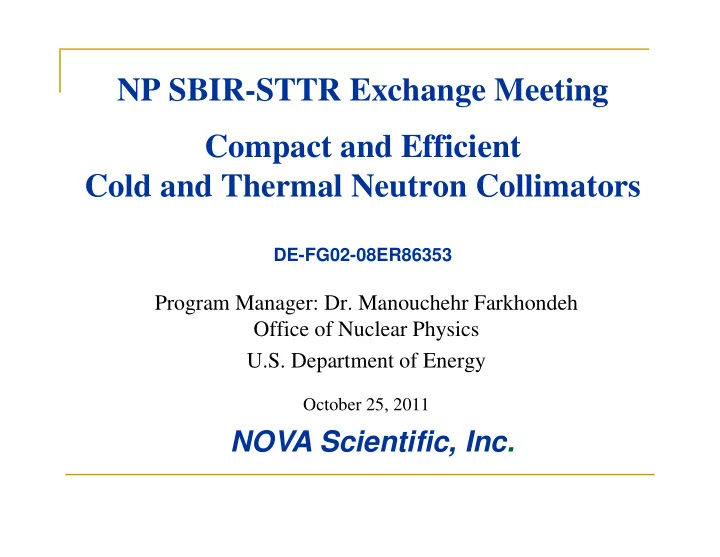

NP SBIR-STTR Exchange Meeting g g Compact and Efficient Cold and Thermal Neutron Collimators DE-FG02-08ER86353 Program Manager: Dr. Manouchehr Farkhondeh g g Office of Nuclear Physics U.S. Department of Energy October 25, 2011 NOVA Scientific, Inc. ,
STTR Project Goals Develop a compact MCP-based 2-D neutron collimator • Improve neutron beam parallelism and quality pre-sample; reduce beam divergence and image blur at the detector • Reduce post-sample scattered neutrons into detector in a very Reduce post sample scattered neutrons into detector, in a very compact space (only a few mm’s thick) • Computer-controlled alignment system Criteria: Rocking curve sharpness Maintain > 50 % neutron throughput Maintain > 50 % neutron throughput, (even at extended L/D) Improved hi-resolution neutron images NOVA Scientific, Inc. 2
Microchannel Plate (MCP) Formats ( Examples shown used for particle detection) ( Examples shown used for particle detection) NOVA Scientific & the University of California-Berkeley Space Science Laboratory now adapting this technology for compact 2-D neutron y p g gy p collimation courtesy Photonis USA S NOVA Scientific, Inc. 3
MCP Structure Typical Diameter 8µm on 10µm centers Typical Diameter 8µm on 10µm centers NOVA Scientific, Inc. 4
10 B and Gd neutron Absorption versus Neutron Energy NOVA Scientific, Inc. 5
Advantages of 2-D MCP-Based Collimation Very compact imaging setups can be implemented with the MCP collimator devices the MCP collimator devices. Long flight paths no longer Long flight paths no longer required between the aperture and the detector. Some beamlines limited in space can greatly benefit; Some beamlines, limited in space, can greatly benefit; enables high resolution tomography and radiography even in a very constrained experimental setup space. Collimation with compact devices substantially improves resolution for ‘large’ (few cm and larger) objects, especially in tomography where objects may be rotated and therefore placed at a distance from the detector active area. active area. NOVA Scientific, Inc. 6
Computer Modeling Very powerful tool for MCP collimator design; has predicted collimator test data with very high accuracy p y g y Avoidance of numerous lengthy and highly expensive glass chemistry design and fabrication runs. Parameters in the model: glass composition ( 10 B or Gd doping levels), geometry (pore L/d and diameter) Output: rocking curves neutron transmission out-of-angle rejection NOVA Scientific, Inc. 7
Experimental Campaign Multiple test runs have been carried out and are continuing using several improved MCP continuing, using several improved MCP collimator test samples. Tests include both neutron beam shaping and scatter rejection. Tests at pulsed and continuous beamlines at: ORNL SNS and HFIR(SNAP, CG-1) PSI (Neutra, FunSpin) ISIS (ROTAX) FRM-11 (Antares) ( ) NOVA Scientific, Inc. 8
Tests with PSI Imaging Resolution Target NOVA Scientific, Inc. 9
Image Improvement Occurs Even at Close Positioning NOVA Scientific, Inc. 10
Even More Advantageous as Sample Is Placed Further from Detector NOVA Scientific, Inc. 11
Considerable Image Improvement Observed NOVA Scientific, Inc. 12
NOVA MCP N NOVA MCP Neutron Detectors t D t t (used in conjunction with the MCP-based collimator tests) Real-time neutron imaging and TOF: ea t e eut o ag g a d O ~10 µm imaging resolution) ~1 µs timing resolution 1 µs timing resolution NOVA Scientific, Inc. 13
Neutron-Sensitive MCP as Detector 10 B (or Gd) incorporated into base glass material material Reactants create secondary electrons - Neutron reactant ranges well-matched to channel wall thickness Secondary e-’s amplified to large ~1ns output pulses e - 7 Li e - e - Spatial resolution set by pore size (5 10 µm) Spatial resolution set by pore size (5-10 µm) e - e e - e 10 B Secondary Timing resolution set by 1mm MCP thickness Electrons (~1 µs) coating to Neutron efficiency ~ 3 He Neutron efficiency ~ 3 He release e - release e Neutron sensitivity/cm 2 > 3 He (1.6-1.7x) NOVA Scientific, Inc. 14
MCP Neutron Detector with Medipix/Timepix Readout (a separate DOE Phase II STTR with UCal-Berkeley) (a separate DOE Phase II STTR with UCal Berkeley) Double MCP stack is placed ~0.5 mm above Medipix2/TimePix readout. Front MCP provides neutron conversion, rear MCP ‘amplifier’ further boosts output pulse to > 10 6 e - for pulse counting further boosts output pulse to > 10 e for pulse counting. NOVA Scientific, Inc. 15
Imaging Examples of MCP Detector with Medipix In collaboration with M. Muehlbauer, B. Schillinger, Fuel injection nozzle Dual energy image acquisition January 2009, FRM2, ANTARES beamline 14 mm 14 mm 1.7 mm 1.7 mm PSI Gd resolution mask 11 m MCP pores are seen 11 m MCP pores are seen Presently very low counting rate NOVA Scientific, Inc. 16
Tomographic Reconstruction MCP Neutron Imager 1 µs timing resolution MCP Neutron Imager, 1 µs timing resolution (5 meV cold neutrons at ICON beamline, PSI) NOVA Scientific, Inc. 17
Tomography Animations Using MCP/Medipix Neutron Detector Reconstructions and visualizations by M. Muehlbauer (TUM) and Anders Kaestner (PSI) NOVA Scientific, Inc. 18
Summary MCP-based neutron collimators can effectively reduce the divergence of lower L/D neutron beamlines MCP collimators can effectively reduce scattering between the target and detector, leading to improved contrast, definition, and resolution t t d fi iti d l ti Nova Scientific’s neutron-sensitive MCP and neutron collimator collimator, together with the Medipix Collaborations’s together with the Medipix Collaborations’s readout, offers an extremely powerful high spatial and timing resolution neutron detection system (~10 µm and ~1 µs). Nova Scientific and UCal-Berkeley appreciate the support of the DOE SBIR-STTR program! NOVA Scientific, Inc. 19
Recommend
More recommend